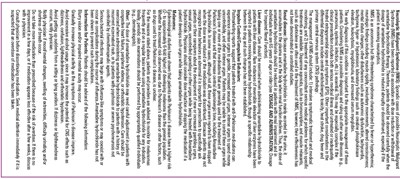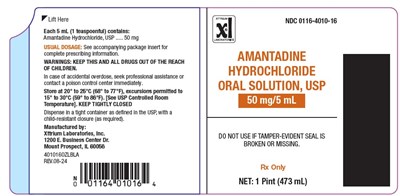Product Images Amantadine
View Photos of Packaging, Labels & Appearance
- Amantadine 16oz label 1 - Amantadine 16oz 1
- Amantadine 16oz label 2 - Amantadine 16oz 2
- Amantadine 16oz label 3 - Amantadine 16oz 3
- Amantadine 16oz label 4 - Amantadine 16oz 4
- Amantadine 16oz label 5 - Amantadine 16oz 5
- Amantadine 16oz 6 label - Amantadine 16oz 6
- Amantadine 16oz Front - Amantadine 16oz Comp.
- Amantadine 5-6 - Amantadine Back 5 6
- Amantadine 7-8 - Amantadine Back 7 8
- Amantadine Table - Amantadine Chart
- Amantadine 1-2 - Amantadine Front 1 2
- Amantadine 3-4 - Amantadine Front 3 4
- Amantadine MC - Amantadine Molecule
- Amantadine 10mL Lid - Amantadine UD 10mL
Product Label Images
The following 14 images provide visual information about the product associated with Amantadine NDC 0116-4010 by Xttrium Laboratories, Inc, such as packaging, labeling, and the appearance of the drug itself. This resource could be helpful for medical professionals, pharmacists, and patients seeking to verify medication information and ensure they have the correct product.
Amantadine 16oz label 1 - Amantadine 16oz 1

This text provides detailed information about Amantadine Hydrochloride, an oral solution with 5mg/5ml concentration. It describes its pharmacological actions as both an anti-Parkinson and an antiviral agent. The text also covers its mechanism of action, clinical pharmacology, pharmacodynamics, pharmacokinetics, and dosing information based on studies in adult male volunteers. The document discusses the metabolism of Amantadine Hydrochloride and its excretion in human urine. Furthermore, it mentions its potential effects on dopamine neurons and its use in the treatment of Parkinson's disease.*
Amantadine 16oz label 2 - Amantadine 16oz 2

This text provides information about the treatment of Influenza A using Amantadine Hydrochloride, its effectiveness in preventing the host immune response, and considerations before using the medication. It also mentions the treatment of Parkinson's Disease/Syndrome with Amantadine Hydrochloride, contraindications, potential side effects, and dosages. Additionally, it warns about overdose, suicidal attempts, mental health issues, and adverse reactions related to the medication. The text emphasizes precautions for patients with renal impairment, Parkinson's disease, and advises on resuming activities cautiously after taking Amantadine Hydrochloride.*
Amantadine 16oz label 3 - Amantadine 16oz 3

The text provides detailed information about the potential side effects and considerations related to the use of amantadine hydrochloride, including Neuroleptic Malignant Syndrome (NMS), renal disease, impulse control/compulsive behaviors, melanoma risk, bacterial infections, and advice for patients on proper medication usage. It discusses specific symptoms to monitor for, such as fever, muscle rigidity, and neurologic changes, and emphasizes the importance of carefully managing the medication to avoid adverse effects. Additionally, it highlights the need for close monitoring of patients for various conditions and urges healthcare providers to take appropriate actions if certain symptoms or behaviors are observed.*
Amantadine 16oz label 4 - Amantadine 16oz 4

This text provides information on drug interactions, warnings, precautions, and usage guidelines for amantadine hydrochloride. It includes details on potential interactions with other medications, effects on fertility, teratogenic effects on embryofetal development, safety in pregnancy, nursing mothers, pediatric use, and elderly patients. The text emphasizes the need for careful monitoring and adjustment of doses in specific populations, such as the elderly and individuals with renal impairment. It also mentions the effects of amantadine hydrochloride on gene mutation, chromosome damage, and impairment of fertility based on various studies conducted on animals and humans.*
Amantadine 16oz label 5 - Amantadine 16oz 5

This is a detailed description of adverse reactions and overdosage information related to amantadine hydrochloride. It provides a list of adverse reactions at different levels of occurrence, such as nausea, dizziness, insomnia, and more severe reactions like congestive heart failure and neuroleptic malignant syndrome. The text also outlines the potential consequences of overdosage, including cardiac, respiratory, renal, and central nervous system toxicity. It suggests general supportive measures and specific interventions like iv physostigmine for controlling central nervous system toxicity. Additionally, it highlights the importance of monitoring vital signs and electrolytes, as well as caution with administering adrenergic agents in cases of overdose.*
Amantadine 16oz 6 label - Amantadine 16oz 6

This is a detailed description of the dosage and administration guidelines for Amantadine hydrochloride, a medication used for various conditions such as influenza A virus illness, Parkinsonism, drug-induced extrapyramidal reactions, and impaired renal function. The text outlines specific dosages for different age groups and medical conditions, emphasizing the importance of adhering to prescribed schedules. It also provides instructions for prophylactic dosing and duration of treatment, highlighting the need for close monitoring and potential dose adjustments based on individual response. Additionally, it includes information on how the medication should be stored and dispensed, along with references for further reading.*
Amantadine 16oz Front - Amantadine 16oz Comp.

This text provides information about an oral solution containing 50mg of Amantadine Hydrochloride, USP per 5mL (1 teaspoonful). It includes instructions on dosage, storage conditions, warnings about overdose, and contact information for the manufacturer. The label also advises not to use the product if the tamper-evident seal is broken or missing. This product is for prescription use only and contains a net volume of 1 pint (473mL).*
Amantadine 5-6 - Amantadine Back 5 6

This text contains information about the medication Amantadine hydrochloride, which is commonly used to treat Parkinson's disease. It discusses potential side effects and adverse reactions such as intense urges to gamble, sexual urges, and uncontrolled spending. It also mentions the importance of physicians monitoring patients for melanoma due to increased risk. The text further provides details on drug interactions and precautions for pregnant women, nursing mothers, and pediatric and elderly patients. It also includes information on dosage adjustments, potential risks, and adverse reactions associated with the medication.*
Amantadine 7-8 - Amantadine Back 7 8

The text provides detailed information about the drug amantadine hydrochloride, including its potential side effects, dosage recommendations, and administration guidelines for various conditions. It covers the management of overdose symptoms, monitoring protocols, dosing for influenza virus illness and Parkinsonism, as well as considerations for pediatric patients and those with impaired renal function. The document also outlines guidelines for concomitant therapies and drug-induced extrapyramidal reactions. Additionally, it includes instructions on how the medication is supplied and stored. The content is essential for healthcare professionals prescribing or managing patients on amantadine hydrochloride.*
Amantadine Table - Amantadine Chart

This text provides information on creatinine clearance calculation (mU/min/A.73m2) and dosage instructions for Amantadine Hydrochloride. It indicates a dosage of 200 mg on the first day and 100 mg daily thereafter. Additionally, an alternative dosing schedule of 200 mg on the first day followed by 100 mg on alternate days is mentioned.*
Amantadine 1-2 - Amantadine Front 1 2

Description: Amantadine Hydrochloride Oral Solution USP is a medication containing 50 mg of amantadine hydrochloride per 5 mL. It is used as an anti-Parkinson and antiviral drug. The solution also includes inactive ingredients like anhydrous citric acid, berry flavor, methylparaben, propylene glycol, propylparaben, purified water, saccharin sodium, sodium citrate dihydrate, and sorbitol solution. This medication acts by preventing the release of infectious viral nucleic acid and proteins. It shows activity against influenza A virus isolates but little to no activity against influenza B virus. The pharmacokinetics of amantadine hydrochloride show it is well absorbed orally and mainly excreted unchanged in the urine. The mechanism of action in treating Parkinson's disease and drug-induced extrapyramidal reactions is not fully understood. Overall, amantadine hydrochloride is effective against certain strains of viruses but can lead to side effects like dry mouth, urinary retention, and constipation.*
Amantadine MC - Amantadine Molecule

This is a chemical formula for a compound with the molecular weight of 187.71 g/mol. It includes the elements NH4, Cl, H, C, and N.*
* The product label images have been analyzed using a combination of traditional computing and machine learning techniques. It should be noted that the descriptions provided may not be entirely accurate as they are experimental in nature. Use the information in this page at your own discretion and risk.

